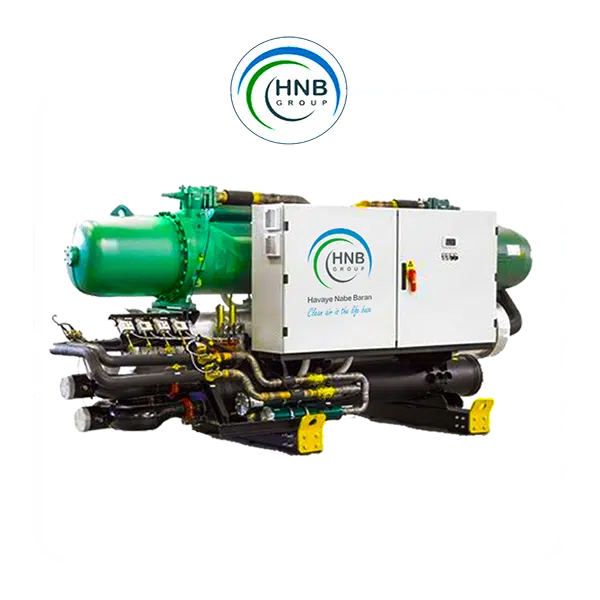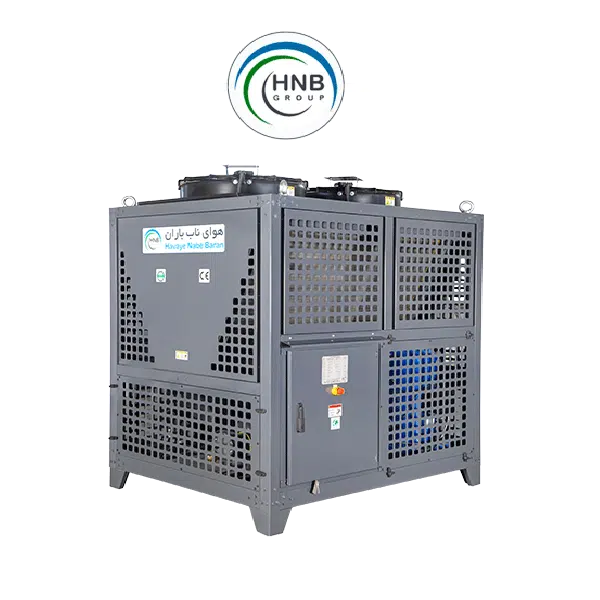Water-cooled chiller
Category: Chiller / Cool Water Chiller
Brand: BOREAS
Application: A water-cooled chiller is a type of compression chiller that uses water as a cooling fluid in the condenser.
Usage locations: Various industries, office and commercial spaces, medical and hospital centers, residential homes.
Water-Cooled Chiller Structure
A water-cooled chiller consists of four main parts and several control and protection components.
The important and main parts that are the same in all compression chillers and are also used in air-cooled and water-cooled chillers include: compressor, condenser, evaporator, and expansion valve (expansion valve).
One of the reasons this device is called a water-cooled chiller is because it depends on a part called its condenser. The condenser of this type of device is water-type, and the hot refrigerant output from the compressor is condensed and cooled by exchanging water with heat in the cooling tower.
Water-cooled chillers have different types based on their application, which are divided into several categories, all of which will be explained below.
The list below shows the types of water-cooled chillers with their applications and components.
- Compressor:
- The heart of the water-cooled chiller is its compressor, which has a direct impact on its price, application, efficiency, dimensions, power consumption, and useful life.
- Condenser:
- One of the important parts of the device is the condensation section in the chiller, which is entrusted to the device’s condenser. This section has different types, including: heat exchange surface and direct relationship with the device’s performance level and life.
- Evaporator:
- The evaporator, as an evaporation unit, indicates the result of the chiller’s performance. In this way, the required cooling is produced in the evaporator of the water-cooled chiller.
Installation Location of Water-Cooled Chillers
Since a water-cooled chiller, unlike an air-cooled chiller, does not require airflow to cool the hot refrigerant inside the condenser, a water-cooled chiller can be installed in any location. Typically, a water-cooled chiller is installed in the lower parts of the building and inside the engine room, but due to the low noise and vibration of the water-cooled chiller, it can also be placed outdoors and on the roof.
If the water-cooled chiller is installed outdoors and on the roof, it is better to place the chiller inside a box so that the compressor and control components are not exposed to sunlight and rain and snow.
In general, a water-cooled chiller is a more suitable and economical choice due to its lower working pressure, higher efficiency, and lower noise and vibration, but it should be noted that its high maintenance and repair costs and high water consumption, especially in the current conditions, reduce its position as the first choice.
A water-cooled chiller cannot be used in areas with high relative humidity. The low subcool temperature in the water-cooled chiller and the low working pressure make it the most suitable option for producing sub-zero cooling in chemical, pharmaceutical, and industrial processes.
Features of Water-Cooled Chillers
- Ability to produce from 5 to 700 tons of refrigeration capacity in one unit by a water-cooled chiller.
- Ability to module chillers together up to 5 units.
- Compressor from the most reputable European brands (Copeland, Danfoss, Bitzer, etc.) with high efficiency, especially for tropical regions.
- Ability to produce devices based on three types of refrigerants: R22, R407C, R134a.
- Ability to use evaporators of Plate and Shell&Tube types based on customer order.
- Evaporator with very high efficiency according to the latest global standards.
- Ability to use condensers of Plate and Shell&Tube types based on customer order.
- The pipes used in the Shell&Tube system are of the CLF type (highest refrigeration efficiency).
- Chassis paint made of polyurethane liquid with a minimum thickness of 120 microns.
- Chassis up to 50 nominal tons of galvanized sheet, bolted type, and in higher tonnages, standard channel or I-beam is used for greater strength.
- Electrical components used from high-quality brands such as Siemens, Danfoss, Schneider, LS, Hyundai, Finder, Atonix, and Technology.
- Valves used in the refrigeration line, all made of high-quality Western European materials such as Castel, GMC, and Alco on the refrigeration line.
- Equipped with high pressure, low pressure, and oil pressure or oil level controllers to protect the compressor.
 Skip to content
Skip to content

